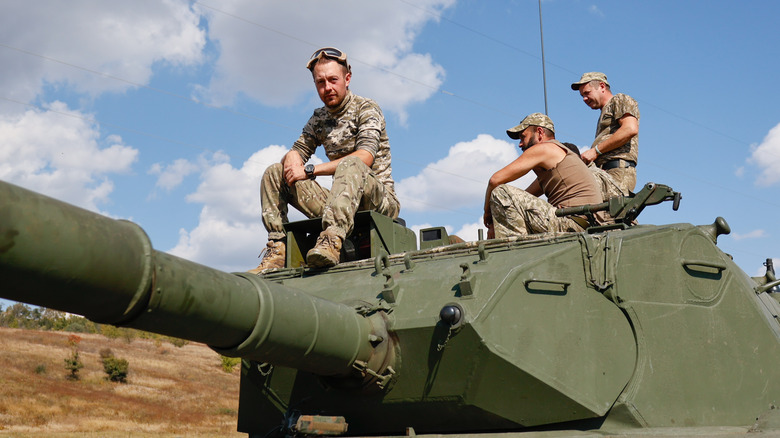6 Common Misconceptions About Tanks You Need To Know
Tanks are a staple of modern military imagery for most people. Hollywood portrays scenes of troops poking their heads out from the tops of metal monstrosities, sweeping through all obstacles with ease. They roll around on impossible terrain, long arms spinning menacingly to find the targets they want to detonate. While this image is blown out of proportion, it's true that tanks can do a lot — but there are also some common misconceptions about these tracked beasts.
Tanks make appearances in everything from Hollywood films like "The Fast and the Furious" and "The Dark Knight Rises," to television shows like "Band of Brothers" attempting to show us a slice of military life. There are even tanks in sitcoms, like a 1964 episode of "The Andy Griffith Show" where Andy thinks his bumbling sheriff Barney Fife has bought a military tank. Griffith pulls the tank over only to find an actual military officer inside. Long story short: tanks are very prevalent in the media, and that contributes to a whole lot of misunderstandings. The tanks that aid soldiers on battlefields vastly differ from the stuff we see on TV.
Thanks to a mixture of Hollywood and general misunderstanding, there's a lot we think we know about tanks that simply may not be right. In this article, we'll go over some of those tank-related "facts" that might seem like common sense but are actually untrue.
Tanks are impervious to all attacks
As thick and intimidating as they look, it's easy to assume that tanks are essentially impenetrable. Even the earliest versions from World War I aren't to be played around with, but almost a century of upgrades should mean they're unbreakable on the battlefield, right? Well, not quite.
Recent military ventures have proven that it doesn't matter how sophisticated and well-protected a tank is, there are still areas of armor to be exploited. Older tanks were vulnerable to weapons specifically made to be used against them. These were small-shaped charges, mines, or other explosives designed to cut through metal.
Newer tanks, though upgraded and adapted, can still be vulnerable to drones. Equipping explosives to drones allows the explosives to be carried to a close enough proximity to the tank to do damage without the tank being able to stop it. When all else fails, brute force can sometimes work. While the armoring on a tank is impressive, if it's hit with enough firepower, it'll still buckle to the sheer force of the attack. With that said, a tank will last through a lot more damage than a car or any other sort of land vehicle.
Tanks are slow
It may seem like something as bulky and heavy as a tank can't be made to move quickly, but that isn't always true. The outlet 24/7 Wall Street used information from an online military vehicle database to rank the fastest tanks. The results are surprising, proving that bulky as they are, tanks can put out quite a lot of speed.
The list starts with the Tank MK V, one of the oldest out there. The Tank MK V was used by the U.K. in World War I, placing its service entry year in 1918. The MK V definitely wasn't going to win any races at its top speed of 4.6 mph. The same can be said about most of the contemporary WWI models.
By World War II, tanks began to pick up speed. The Sherman style of tanks (which include tanks like the Sherman Jumbo, the M4A3, and M4 Sherman) were considered medium to heavy and could typically hit speeds between 20 and 24 mph.
According to the research done by 24/7 Wall Street, the lightest tanks are the fastest. The top three on the list are the M551 Sheridan at 43.5 mph, the M1 at 44.7 mph, and the official fastest tank — the M41 Walker Bulldog. The M41 is a U.S. military tank used in the Korean and Vietnam wars, and it can hit 45 mph at top speeds. Just for a fun comparison, this is the same speed a horse can run. Giddy up!
There's only one person inside a tank
Media loves to portray the scene of the door to a tank opening, and a singular person pops their head out of the top. This might make for a good and easy-to-understand Hollywood scene, but it isn't exactly realistic. Tanks actually have a full crew operating them.
Different tanks have a different number of crew members, but just to illustrate the various types of roles, we'll take a look at the crew of an M1 tank. M1s are designed to be operated by four people: the driver, the loader, the gunner, and the commander.
An M1's driver stays directly under the main gun, in the front portion of the tank. They're the ones that movies and television shows often portray sitting or reclining in a bucket seat to be able to access all of the controls for driving. Their ability to see where they're going comes from three periscopes, one of which has a night vision sensor for driving at night. The driver also keeps an eye on their instrument panel to make sure everything is operating smoothly.
The rest of the crew sits further to the back of the tank, in what's called the turret basket. The loader feeds ammunition into the main gun while the gunner handles enemy targeting and firing. The commander makes sure there's clear communication between all parts and also keeps an eye on the landscape through the periscopes and their own integrated display.
Purchased surplus military tanks are street legal
Military vehicles are often sold at surplus sales and auctions ... but that doesn't actually mean you're free to pick one up and take it on a joy ride through town. Most states will allow you to purchase one as long as it's been demilitarized, which means that the weaponry has been disabled.
According to John McCoy, a former Air Force chief crew who now writes automotive articles on the website DirtLegal, the main concerns are weight and traction. The U.S. Department of Transportation has the federally mandated maximum vehicle weight set at 80,000 pounds gross. This is 20,000 pounds less than the average weight of an M60 battle tank, mostly due to the heavy armor plating around it that would be difficult to remove.
The Department of Transportation has these limits set based on what roads can handle. That means that a tank, even if it were street legal, could still cause damage to bridges, older surfaces, and fire roads that you would then be liable for. There may also be clearance issues with overpasses.
It might seem like an inane difference, but what you're allowed to own and what you're allowed to drive off of public property can be two very different things. If you're thinking of living your childhood dreams by buying one, just make sure you consult your state and local regulations first.
Tanks are obsolete now
Some have said that tanks are useless pieces of military hardware since the early 1980s. Technology was being invented then that was theorized to be the death of tanks, but 30 years later, they still see regular use ... unlike the projectiles that were meant to cause their demise.
Back then — and even still in recent years — people often fail to take into account that tanks are never the sole offense or defense being used. While tanks may be susceptible to anti-tank guns, air support can help mitigate that. This is a lesson that all successful armies have learned, from both sides of World War II in the 1940s to the Israeli armies in the 1950s and 1960s, to military operations happening now.
As long as warfare takes place with soldiers on the ground, they'll need stable and protective ways to cross that ground. Tanks will likely continue to be used, as they always have been, alongside a multitude of other defensive measures.
Armor is the most important part of a tank
Tanks are armored vehicles, so obviously, the armor itself plays a role in why they're such useful military weapons. However, a lot of people incorrectly assume that the armor itself is why tanks are so successful, but that isn't completely true.
In fact, over the years as tank design has undergone its many evolutions, some of the tanks relied on most in war scenarios didn't have nearly as much armor as their less successful counterparts. This is partially thanks to newer weapon technology that could pierce even the thickest armor, making it more efficient to make tanks equally offensive and defensive.
The most widely used and celebrated versions have an equal emphasis on firepower, mobility, and armor. A tank can be so well-armored that nothing penetrates, but it still isn't winning a battle if it can't actually damage or destroy enemy targets or if it can't travel any distances.






